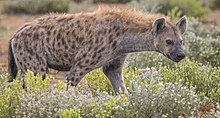Hello ladies and gents this is the viking telling you that today we are talking about

Hyenas or hyaenas are any feliform carnivoran mammals of the family Hyaenidae /haɪˈɛnɪdiː/. With only four extant species (in three genera), it is the fifth-smallest biological family in the Carnivora, and one of the smallest in the class Mammalia. Despite their low diversity, hyenas are unique and vital components of most African ecosystems.
Although phylogenetically they are closer to felines and viverrids, and belong to the feliform category, hyenas are behaviourally and morphologically similar to canines in several elements of convergent evolution; both hyenas and canines are non-arboreal, cursorial hunters that catch prey with their teeth rather than claws. Both eat food quickly and may store it, and their calloused feet with large, blunt, nonretractable claws are adapted for running and making sharp turns. However, the hyenas' grooming, scent marking, defecating habits, mating and parental behaviour are consistent with the behaviour of other feliforms.
Spotted hyenas may kill as many as 95% of the animals they eat, while striped hyenas are largely scavengers.Generally, hyenas are known to drive off larger predators, like lions, from their kills, despite having a reputation in popular culture for being cowardly. Hyenas are primarily nocturnal animals, but sometimes venture from their lairs in the early-morning hours. With the exception of the highly social spotted hyena, hyenas are generally not gregarious animals, though they may live in family groups and congregate at kills.
 Hyenas first arose in Eurasia during the Miocene period from viverrid-like ancestors, and diversified into two distinct types: lightly built dog-like hyenas and robust bone-crushing hyenas. Although the dog-like hyenas thrived 15 million years ago (with one taxon having colonised North America), they became extinct after a change in climate along with the arrival of canids into Eurasia. Of the dog-like hyena lineage, only the insectivorous aardwolf survived, while the bone-crushing hyenas (including the extant spotted, brown and striped hyenas) became the undisputed top scavengers of Eurasia and Africa.
Hyenas first arose in Eurasia during the Miocene period from viverrid-like ancestors, and diversified into two distinct types: lightly built dog-like hyenas and robust bone-crushing hyenas. Although the dog-like hyenas thrived 15 million years ago (with one taxon having colonised North America), they became extinct after a change in climate along with the arrival of canids into Eurasia. Of the dog-like hyena lineage, only the insectivorous aardwolf survived, while the bone-crushing hyenas (including the extant spotted, brown and striped hyenas) became the undisputed top scavengers of Eurasia and Africa.
Hyenas feature prominently in the folklore and mythology of human cultures that live alongside them. Hyenas are commonly viewed as frightening and worthy of contempt. In some cultures, hyenas are thought to influence people’s spirits, rob graves, and steal livestock and children. Other cultures associate them with witchcraft, using their body parts in traditional African medicine.
And as always have a chilled day from the viking
HYENA

Hyenas or hyaenas are any feliform carnivoran mammals of the family Hyaenidae /haɪˈɛnɪdiː/. With only four extant species (in three genera), it is the fifth-smallest biological family in the Carnivora, and one of the smallest in the class Mammalia. Despite their low diversity, hyenas are unique and vital components of most African ecosystems.
Although phylogenetically they are closer to felines and viverrids, and belong to the feliform category, hyenas are behaviourally and morphologically similar to canines in several elements of convergent evolution; both hyenas and canines are non-arboreal, cursorial hunters that catch prey with their teeth rather than claws. Both eat food quickly and may store it, and their calloused feet with large, blunt, nonretractable claws are adapted for running and making sharp turns. However, the hyenas' grooming, scent marking, defecating habits, mating and parental behaviour are consistent with the behaviour of other feliforms.
Spotted hyenas may kill as many as 95% of the animals they eat, while striped hyenas are largely scavengers.Generally, hyenas are known to drive off larger predators, like lions, from their kills, despite having a reputation in popular culture for being cowardly. Hyenas are primarily nocturnal animals, but sometimes venture from their lairs in the early-morning hours. With the exception of the highly social spotted hyena, hyenas are generally not gregarious animals, though they may live in family groups and congregate at kills.
Hyenas feature prominently in the folklore and mythology of human cultures that live alongside them. Hyenas are commonly viewed as frightening and worthy of contempt. In some cultures, hyenas are thought to influence people’s spirits, rob graves, and steal livestock and children. Other cultures associate them with witchcraft, using their body parts in traditional African medicine.
And as always have a chilled day from the viking
Comments
Post a Comment